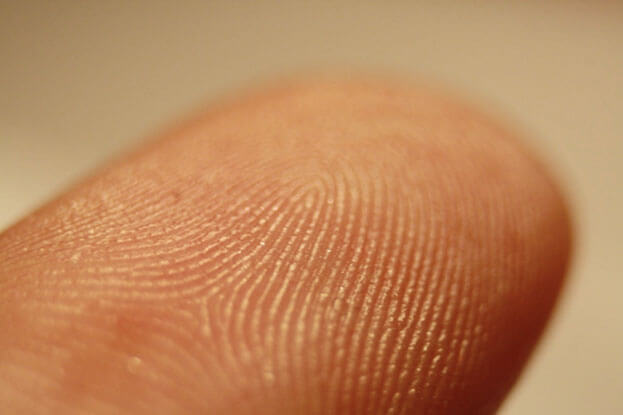
by Kourosh Nikoui | July 10, 2024 | Fingerprints
Fingerprints are unique to each individual, including identical twins, and serve as a crucial tool in forensic science for personal identification. But how exactly do these intricate patterns develop on the palmar surfaces of our hands and feet? This blog article delves into the fascinating process of friction ridge development in the womb, the factors contributing to their uniqueness, and the anatomy and physiology of these enduring structures.
The formation of fingerprints, or friction ridges, begins early in fetal development. Here’s a timeline of how these unique patterns emerge:
Weeks 6-7: The basic shape of the hand and foot forms. During this period, the dermal layers of the skin start to differentiate, laying the foundation for the intricate patterns that will later develop.
Weeks 10-12: The primary ridge formations begin. These ridges are the basis for what will become the fingerprint patterns. They start as small, localized swellings in the epidermis. These early formations are crucial as they set the stage for the complexity of the final fingerprint.
Weeks 13-19: The ridges proliferate and establish the unique patterns we recognize as fingerprints. By this time, the volar pads (swollen tissue under the skin) influence the overall ridge patterns. The height, size, and shape of these pads play a significant role in determining the pattern type (loops, whorls, or arches). This period is critical as the final layout of the ridges gets locked in.
Several factors influence the development of friction ridges during this period:
Genetic Factors: While the overall pattern type (arch, loop, whorl) is genetically influenced, the fine details are not strictly determined by genes alone. This is why even identical twins, who share the same genetic makeup, have distinct fingerprints. These genetic factors set the stage, but they do not dictate the fine details, making each fingerprint unique.
Environmental Factors: The intrauterine environment, including the density of amniotic fluid, the position of the fetus, and slight differences in the growth rate of cells, contribute to the unique ridge formations. These minor variations lead to the distinct minutiae in fingerprints. Factors like the fetus’s movement and pressure on the uterine wall further individualize the prints.
The friction ridge skin on our hands and feet has unique anatomical features that differentiate it from other types of skin on the body.
Epidermis and Dermis: The friction ridge skin is composed of an outer epidermal layer and a deeper dermal layer. The epidermis contains the actual ridge patterns, while the dermal layer supports these ridges. This dual-layer structure ensures durability and the ability to regenerate the ridge patterns after minor damage.
Sweat Glands: These ridges are interspersed with numerous sweat glands, which are essential for the function of fingerprints. The sweat from these glands helps leave a print when we touch a surface. This natural secretion is what makes latent prints detectable at crime scenes.
Flexibility and Resilience: Friction ridge skin is highly flexible and resilient, allowing it to withstand the wear and tear from daily activities while maintaining the ridge structure. This flexibility is crucial for the skin’s ability to recover from minor injuries without losing the fingerprint pattern.
Once formed, fingerprints remain largely unchanged throughout a person’s life. Here’s why they are so stable:
Deep-Rooted Structures: The ridges are anchored deeply in the dermal layer of the skin. Even if the outer layer of skin is damaged, the ridge pattern typically regenerates because the blueprint is preserved in the deeper layers. This deep anchoring ensures that minor abrasions do not alter the fingerprint.
No Natural Regeneration Changes: Unlike some cells in the body that renew and change, the cells in the friction ridge skin replicate in a manner that preserves the ridge patterns. The skin’s renewal process is designed to maintain these patterns consistently over a lifetime.
Factors Influencing Permanency: The only factors that can alter fingerprints are significant injuries, diseases that affect the skin, or intentional alterations like surgery or skin grafts. Such changes are rare and usually require substantial damage or intervention.
The development of fingerprints is a complex interplay of genetic and environmental factors occurring early in fetal life. These unique patterns are deeply rooted in our skin’s anatomy and remain stable throughout our lives, barring significant trauma or intentional alteration. This permanency makes fingerprints an invaluable tool for personal identification in forensic science.
Understanding the science behind fingerprint formation not only fascinates but also underscores the intricate biological processes that make each individual unique. As research continues to uncover more about the subtleties of fingerprint development, our appreciation for this remarkable aspect of human anatomy only grows. For fingerprint analysts, forensic investigators, and crime scene investigators, this knowledge is crucial in ensuring accurate identifications and maintaining the integrity of forensic examinations.
Forensic Investigator and Specialist Kourosh Nikoui, Principal Consultant and CEO of Nikoui & Associates, Forensic Identification Services & Consulting, Inc., has over 38 years of full-time experience in forensic science and criminal justice with various law enforcement agencies, government and private entities. Mr. Nikoui, a court-qualified expert, is a Certified Latent Print Examiner, Certified Senior Crime Scene Analyst, and Certified Forensic Photographer by the International Association for Identification. He has testified as an expert witness over 150 times in California Superior and U.S. Federal Courts, processed evidence in over 30,000 criminal and civilian cases, and served as a consultant to numerous law enforcement agencies. Mr. Nikoui holds a BFA degree from USD and is an active member of multiple forensic science organizations. He can be reached directly by calling (866)439-6753 or by email at [email protected]